Enhanced Turbulent Mixing in the Upper Ocean Induced by Super Typhoon Goni (2015)
Abstract
:1. Introduction
2. Data and Methodology
2.1. Super Typhoon Goni
2.2. Data
2.3. Methodology
2.3.1. Gregg–Henyey–PolzinParameterization
2.3.2. Near-Inertial Kinetic Energy (NIKE)
3. Ocean Response to Super TyphonGoni
3.1. Satellite-Observed SST Cooling
3.2. Goni-Induced Mixing
3.3. Goni-Induced NIKE
4. Discussion
5. Conclusions
Author Contributions
Funding
Data Availability Statement
Conflicts of Interest
Appendix A

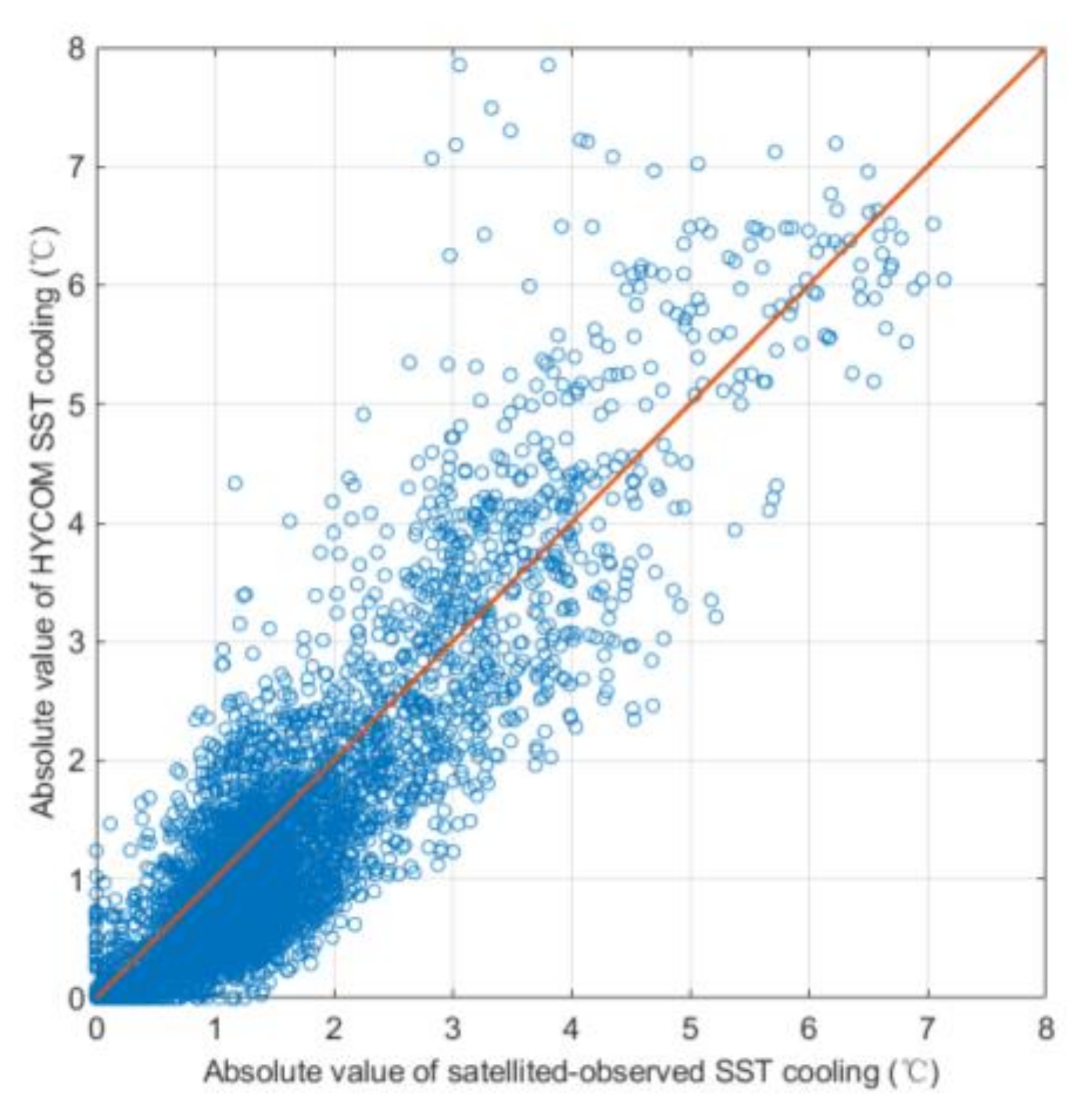
References
- Emanuel, K.A. Thermodynamic control of hurricane intensity. Nature 1999, 401, 665–669. [Google Scholar] [CrossRef]
- Emanuel, K.A. Tropical cyclones. Annu. Rev. Earth Planet. Sci. 2003, 31, 75–104. [Google Scholar] [CrossRef]
- Sanford, T.B.; Price, J.F.; Girton, J.B.; Webb, D.C. Highly resolved observations and simulations of the ocean response to a hurricane. Geophys. Res. Lett. 2007, 34. [Google Scholar] [CrossRef] [Green Version]
- Price, J.F. Upper Ocean Response to a Hurricane. J. Phys. Oceanogr. 1981, 11, 153–175. [Google Scholar] [CrossRef] [Green Version]
- Chang, S.; Anthes, R. Numerical simulations of the ocean’s nonlinear baroclinic response to translating hurricanes. J. Phys. Oceanogr. 1978, 8, 468–480. [Google Scholar] [CrossRef] [Green Version]
- Lin, I.I.; Black, P.; Price, J.F.; Yang, C.Y.; Chen, S.S.; Lien, C.C.; Harr, P.; Chi, N.H.; Wu, C.C.; D’Asaro, E.A. An ocean coupling potential intensity index for tropical cyclones. Geophys. Res. Lett. 2013, 40, 1878–1882. [Google Scholar] [CrossRef]
- Black, W.J.; Dickey, T.D. Observations and analyses of upper ocean responses to tropical storms and hurricanes in the vicinity of Bermuda. J. Geophys. Res. 2008, 113, C08009. [Google Scholar] [CrossRef] [Green Version]
- D’Asaro, E.A.; Sanford, T.B.; Niiler, P.P.; Terrill, E.J. Cold wake of hurricane Frances. Geophys. Res. Lett. 2007, 34, L15609. [Google Scholar] [CrossRef]
- Hsu, H.H.; Hung, C.H.; Lo, A.K.; Wu, C.C.; Hung, C.W. Influence of tropical cyclones on the estimation of climate variability in the tropical western North Pacific. J. Clim. 2008, 21, 2960–2975. [Google Scholar] [CrossRef]
- Lin, I.I.; Wu, C.; Chiang, J.C.H.; Sui, C.; Lin, I.; Liu, W.T. Satellite observations of modulation of surfacewinds by typhoon-induced upper ocean cooling. Geophys. Res. Lett. 2003, 30, 1131. [Google Scholar] [CrossRef]
- Meyers, P.C.; Shay, L.K.; Brewster, J.K.; Jaimes, B. Observed ocean thermal response to Hurricanes Gustav and Ike. J. Geophys. Res. Ocean. 2016, 121, 162–179. [Google Scholar] [CrossRef]
- Wu, R.; Li, C. Upper ocean response to the passage of two sequential typhoons. Deep. Sea Res. Part I Oceanogr. Res. Pap. 2018, 132, 68–79. [Google Scholar] [CrossRef]
- Yue, X.X.; Zhang, B.; Liu, G.Q.; Li, X.F.; Zhang, H.; He, Y.J. Upper Ocean Response to Typhoon Kalmaegi and Sarikain the South China Sea from Multiple-Satellite Observations and Numerical Simulations. Remote Sens. 2018, 10, 348. [Google Scholar] [CrossRef] [Green Version]
- Zhang, H.; Chen, D.; Zhou, L.; Liu, X.; Ding, T.; Zhou, B. Upper ocean response to Typhoon Kalmaegi (2014). J. Geophys. Res. Ocean. 2016, 121, 6520–6535. [Google Scholar] [CrossRef]
- Emanuel, K.; Desautels, C.; Holloway, C.; Korty, R. Environmental Control of Tropical Cyclone Intensity. J. Atmos. Sci. 2004, 61, 843–858. [Google Scholar] [CrossRef]
- Zhu, T.; Zhang, D.L. The impact of the storm-induced SST cooling on hurricane intensity. Adv. Atmos. Sci. 2006, 23, 14–22. [Google Scholar] [CrossRef] [Green Version]
- Samson, G.; Giordani, H.; Caniaux, G.; Roux, F. Numerical investigation of an oceanic resonant regime induced by hurricane winds. Ocean Dyn. 2009, 59, 565–586. [Google Scholar] [CrossRef]
- Wang, G.; Wu, L.; Johnson, N.C.; Ling, Z. Observed three-dimensional structure of ocean cooling induced by Pacific tropical cyclones. Geophys. Res. Lett. 2016, 43, 7632–7638. [Google Scholar] [CrossRef]
- Lin, S.; Zhang, W.Z.; Shang, S.P.; Hong, H.S. Ocean response to typhoons in the western north pacific: Composite results from argo data. Deep. Sea Res. Part I Oceanogr. Res. Pap. 2017, 123, 62–74. [Google Scholar] [CrossRef]
- Zhang, H.; He, H.; Zhang, W.Z.; Tian, D. Upper ocean response to tropical cyclones: A review. Geosci. Lett. 2021, 8, 1. [Google Scholar] [CrossRef]
- Cheng, L.; Zhu, J.; Sriver, R.L. Global representation of tropical cyclone-induced short-term ocean thermal changes using Argo data. Ocean Sci. 2015, 11, 2831–2878. [Google Scholar] [CrossRef] [Green Version]
- Huang, P.; Lin, I.I.; Chou, C.; Huang, R.H. Change in ocean subsurface environment to suppress tropical cyclone intensification under global warming. Nat. Commun. 2015, 6, 7188. [Google Scholar] [CrossRef] [PubMed] [Green Version]
- Jaimes, B.; Shay, L.K.; Uhlhorn, E.W. Enthalpy and momentum fluxes during Hurricane Earl relative to underlying ocean features. Mon. Weather Rev. 2015, 143, 111–131. [Google Scholar] [CrossRef]
- Schade, L.R.; Emanuel, K.A. The ocean’s effect on the intensity of tropical cyclones: Results from a simple coupled atmosphere-ocean model. J. Atmos. Sci. 1997, 56, 642–651. [Google Scholar] [CrossRef] [Green Version]
- Jacob, S.D.; Shay, L.K.; Mariano, A.J.; Black, P.G. The 3D oceanic mixed layer response to hurricane Gilbert. J. Phys. Oceanogr. 2000, 30, 1407–1429. [Google Scholar] [CrossRef]
- Huang, P.; Sanford, T.B.; Imberger, J. Heat and Turbulent Kinetic Energy Budgets for Surface Layer Cooling Induced by the Passage of Hurricane Frances (2004). J. Geophys. Res. Ocean. 2009, 114. [Google Scholar] [CrossRef]
- Guan, S.D.; Zhao, W.; Huthnance, J.; Tian, J.W.; Wang, J.H. Observed upper ocean response to typhoon Megi (2010) in the Northern South China Sea. J. Geophys. Res. Ocean. 2014, 119, 3134–3157. [Google Scholar] [CrossRef] [Green Version]
- Sriver, R.L.; Huber, M. Observational evidence for an ocean heat pump induced by tropical cyclones. Nature 2007, 447, 577–580. [Google Scholar] [CrossRef]
- Jaimes, B.; Shay, L.K. Mixed layer cooling in mesoscale oceanic eddies during hurricanes Katrina and Rita. Mon. Weather Rev. 2009, 137, 4188–4207. [Google Scholar] [CrossRef] [Green Version]
- Balaguru, K.; Chang, P.; Saravanan, R.; Leung, L.R.; Xu, Z.; Li, M.; Hsieh, J.S. Ocean barrier layers’ effect on tropical cyclone intensification. Proc. Natl. Acad. Sci. USA 2012, 109, 14343–14347. [Google Scholar] [CrossRef] [Green Version]
- Sun, J.; Oey, L.Y.; Chang, R.; Xu, F.; Huang, S.M. Ocean response to typhoonNuri (2008) in western Pacific and South China Sea. Ocean Dyn. 2015, 65, 735–749. [Google Scholar] [CrossRef]
- Guan, S.D.; Zhao, W.; Sun, L.; Zhou, C.; Liu, Z.; Hong, X.; Zhang, Y.H.; Tian, J.W.; Hou, Y.J. Tropical cyclone-induced sea surface cooling over the yellow sea and bohai sea in the 2019 pacific typhoon season. J. Mar. Syst. 2021, 217, 103509. [Google Scholar] [CrossRef]
- Cao, A.Z.; Guo, Z.; Pan, Y.H.; Song, J.B.; He, H.L.; Li, P.L. Near-Inertial Waves Induced by Typhoon Megi(2010) in the South China Sea. J. Mar. Sci. Eng. 2021, 9, 440. [Google Scholar] [CrossRef]
- Yang, B.; Hu, P.; Hou, Y.J. Observed Near-Inertial Waves in the Northern South China Sea. Remote Sens. 2021, 13, 3223. [Google Scholar] [CrossRef]
- Guan, S.D.; Liu, Z.; Song, J.B.; Hou, Y.J.; Feng, L.Q. Upper ocean response to Super Typhoon Tembin (2012) explored using multiplatform satellites and Argo float observations. Int. J. Remote Sens. 2017, 38, 5150–5167. [Google Scholar] [CrossRef]
- Ying, M.; Zhang, W.; Yu, H.; Lu, X.Q.; Feng, J.X.; Fan, Y.X.; Zhu, Y.T.; Chen, D.Q. An Overview of the China Meteorological Administration Tropical Cyclone Database. J. Atmos. Ocean. Technol. 2014, 31, 287–301. [Google Scholar] [CrossRef] [Green Version]
- Lu, X.Q.; Yu, H.; Ying, M.; Zhao, B.K.; Zhang, S.; Lin, L.M.; Bai, L.N.; Wan, R.J. Western North Pacific tropical cyclone database created by the China Meteorological Administration. Adv. Atmos. Sci. 2021, 38, 690–699. [Google Scholar] [CrossRef]
- Kunze, E.; Firing, E.; Hummon, J.M.; Chereskin, T.K.; Thurnherr, A.M. Global abyssal mixing inferred from lowered ADCP shear and CTD strain profiles. J. Phys. Oceanogr. 2006, 36, 1553–1576. [Google Scholar] [CrossRef] [Green Version]
- Garrett, C.; Munk, W. Space-time scales of internal waves: A progress report. J. Geophys. Res. 1975, 80, 291–297. [Google Scholar] [CrossRef]
- Jing, Z.; Wu, L.X.; Li, L.; Liu, C.Y.; Liang, X.; Chen, Z.H.; Hu, D.X.; Liu, Q.Y. Turbulent diapycnal mixing in the subtropical northwestern Pacific: Spatial-seasonal variations and role of eddies. J. Geophys. Res. 2011, 116, C10028. [Google Scholar] [CrossRef]
- Whalen, C.B.; MacKinnon, J.A.; Talley, L.D. Large-scale impacts of the mesoscale environment on mixing from wind-driven internal waves. Nat. Geosci. 2018, 11, 842–847. [Google Scholar] [CrossRef]
- Jing, Z.; Wu, L.X. Seasonal variation of turbulent diapycnal mixing in the northwestern Pacific stirred by wind stress. Geophys. Res. Lett. 2010, 37, L23604. [Google Scholar] [CrossRef]
- Wu, L.; Jing, Z.; Riser, S.; Visbeck, M. Seasonal and spatial variations of Southern Ocean diapycnal mixing from Argo profiling floats. Nat. Geosci. 2011, 4, 363–366. [Google Scholar] [CrossRef]
- Gregg, M.C.; Kunze, E. Shear and strain in Santa Monica Basin. J. Geophys. Res. 1991, 96, 16709–16719. [Google Scholar] [CrossRef]
- Munk, W.; Wunsch, C. Abyssal Recipes II: Energetics of Tidal and Wind Mixing. Deep. Sea Res. Part IOceanogr. Res. Pap. 1998, 45, 1977–2010. [Google Scholar] [CrossRef]
- Price, J.F.; Sanford, T.B.; Forristall, G.Z. Forced stage response to a moving hurricane. J. Phys. Oceanogr. 1994, 24, 233–260. [Google Scholar] [CrossRef]
- Ling, Z.; Chen, Z.; Wang, G.; He, H.; Chen, C. Recovery ofTropical Cyclone Induced SSTCooling Observed by Satellite in theNorthwestern Pacific Ocean. Remote Sens. 2021, 13, 3781. [Google Scholar] [CrossRef]
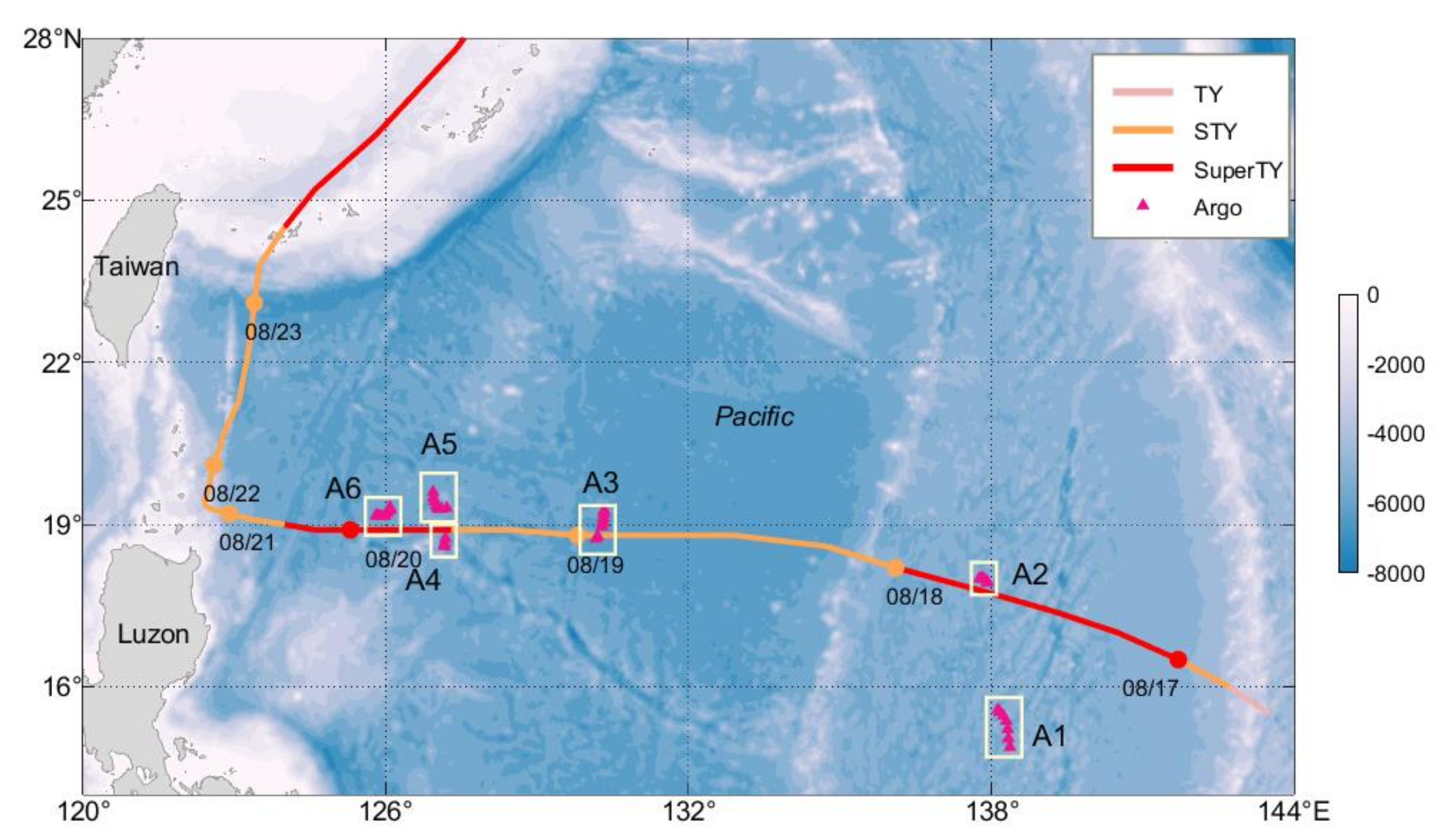
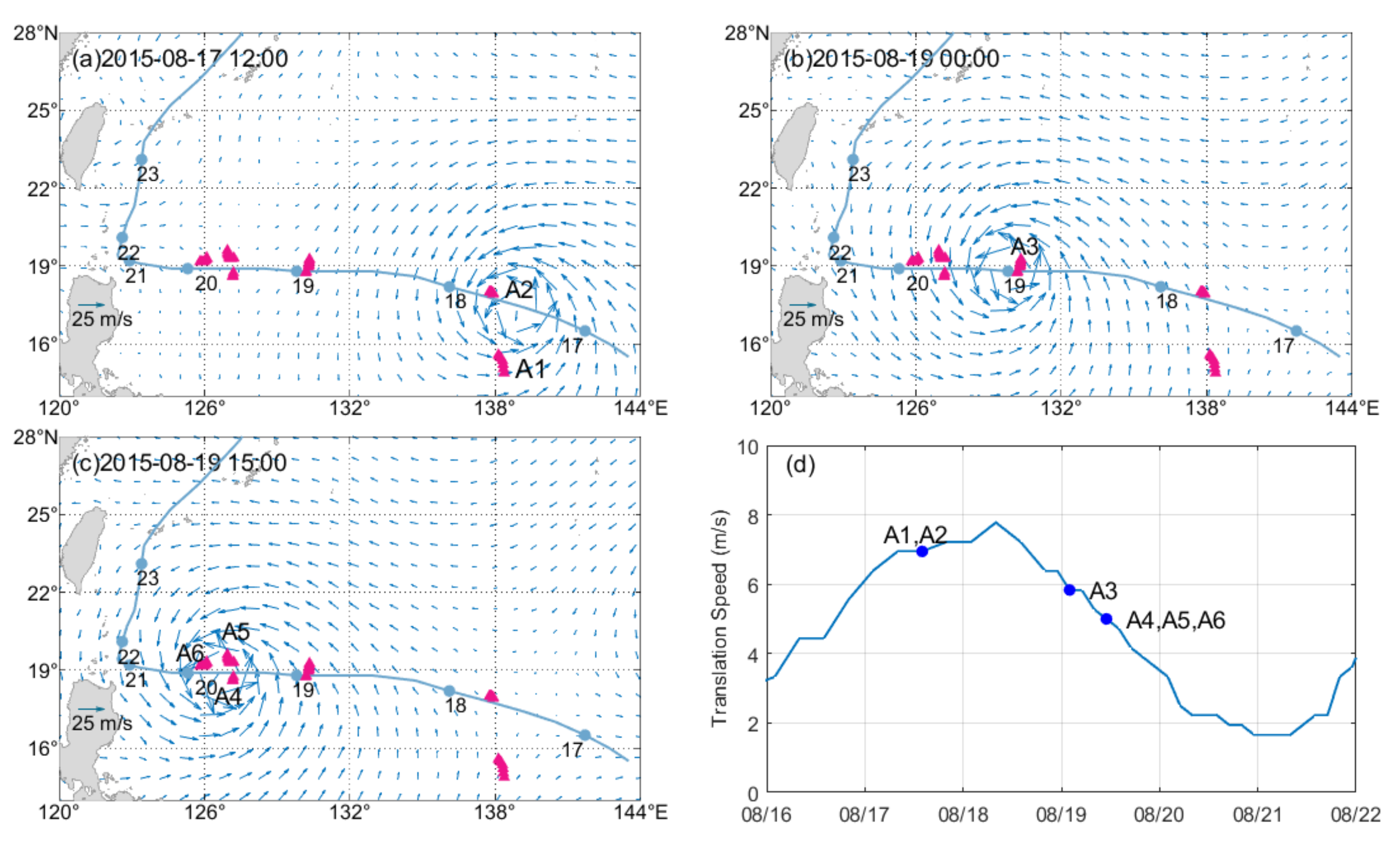
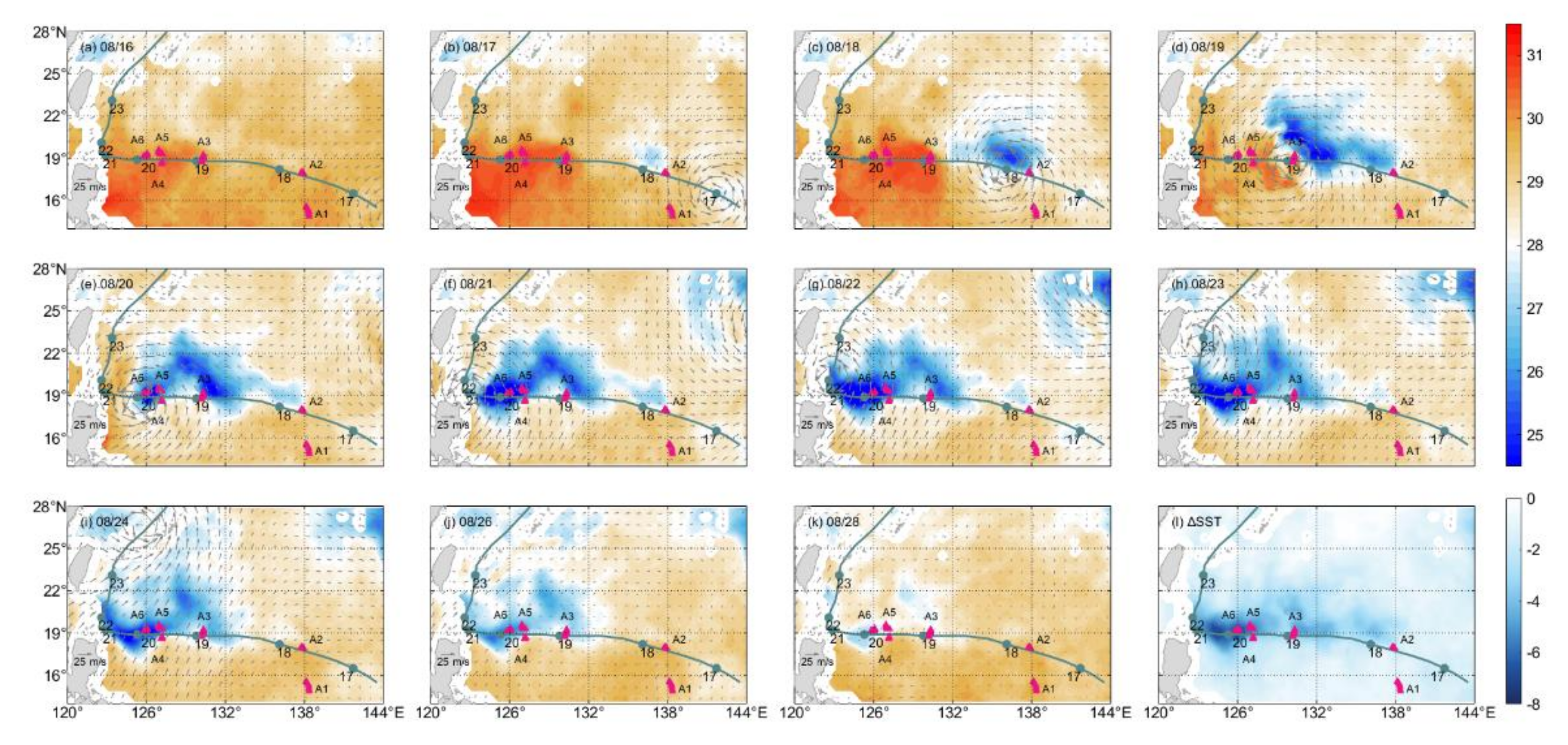
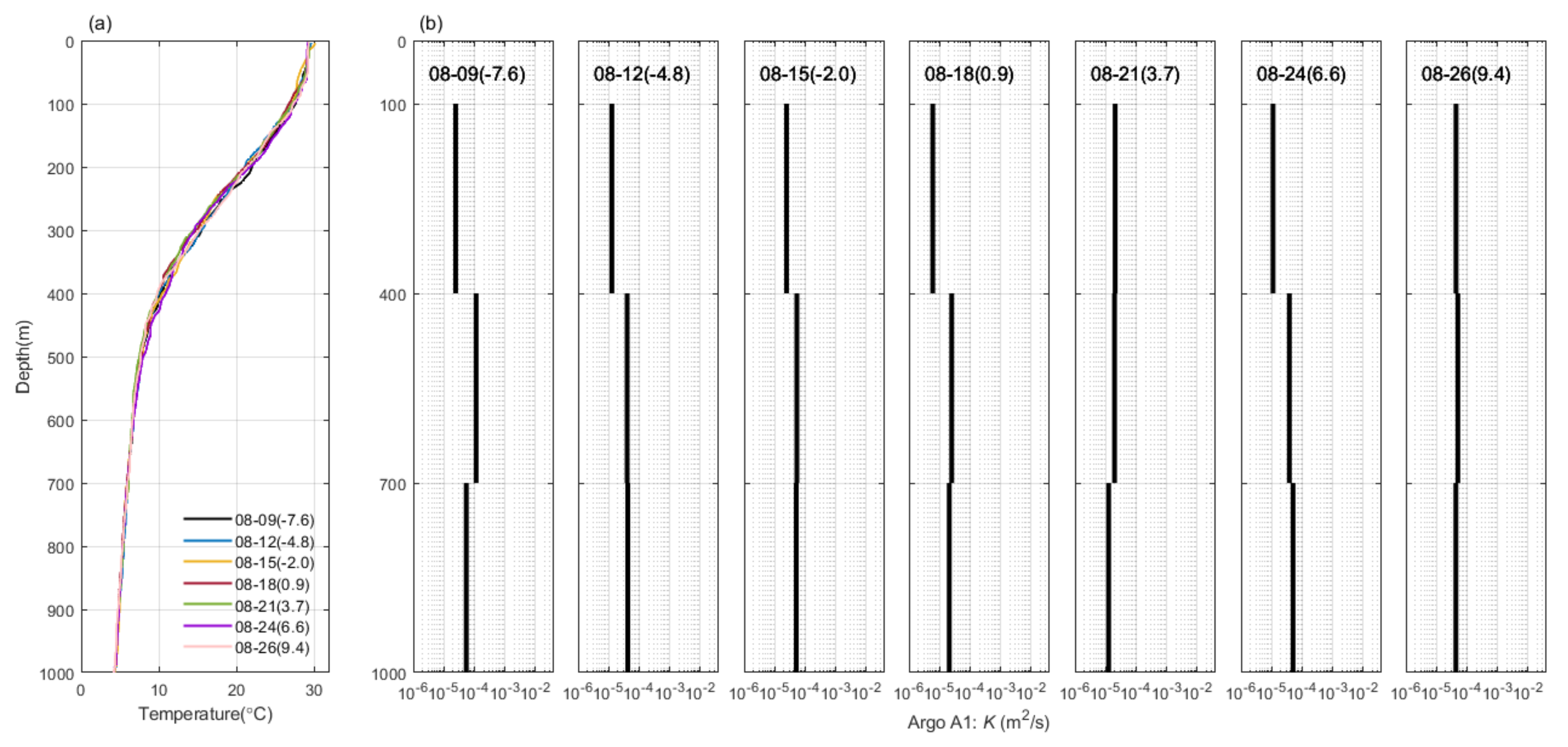
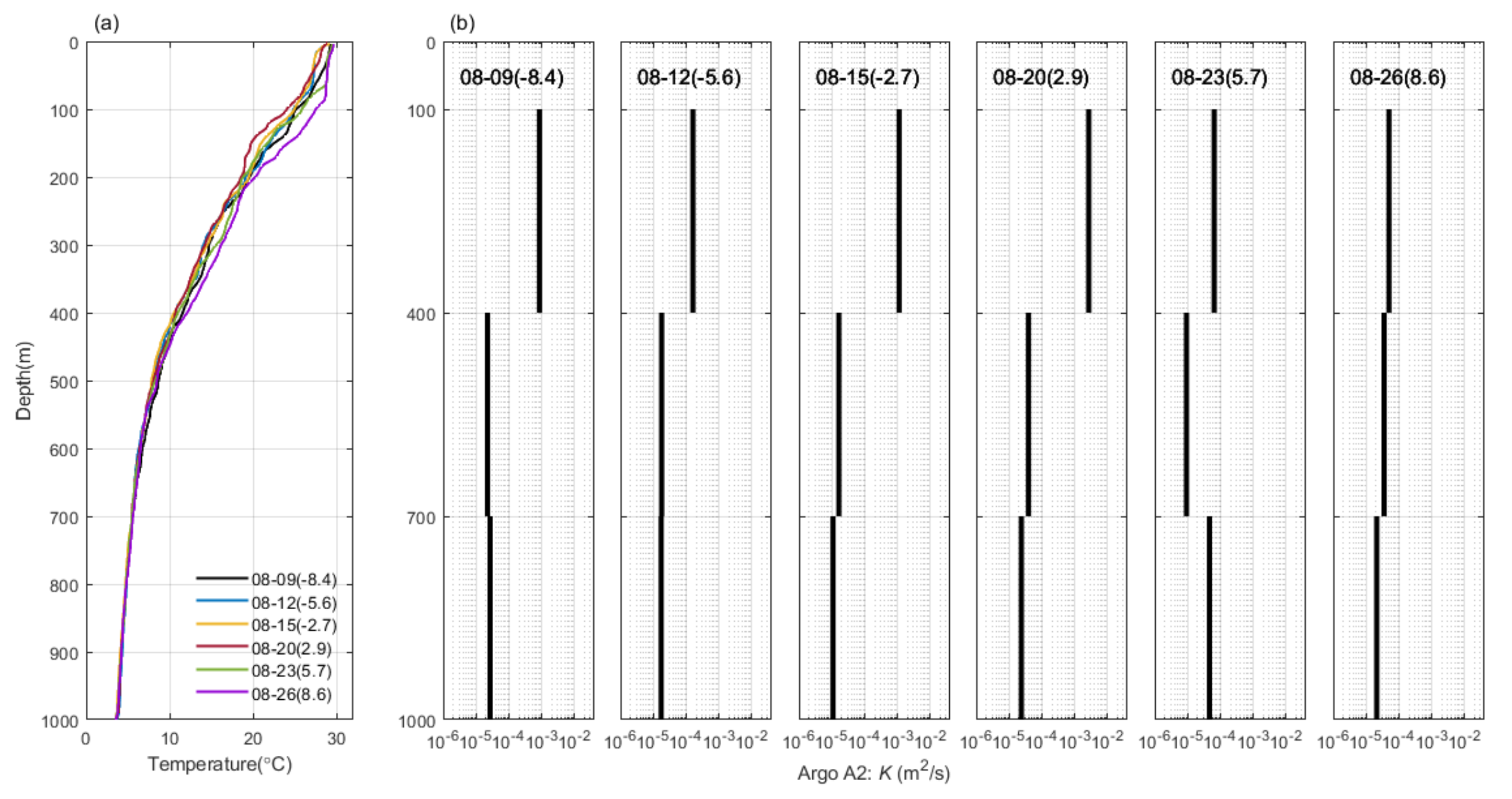
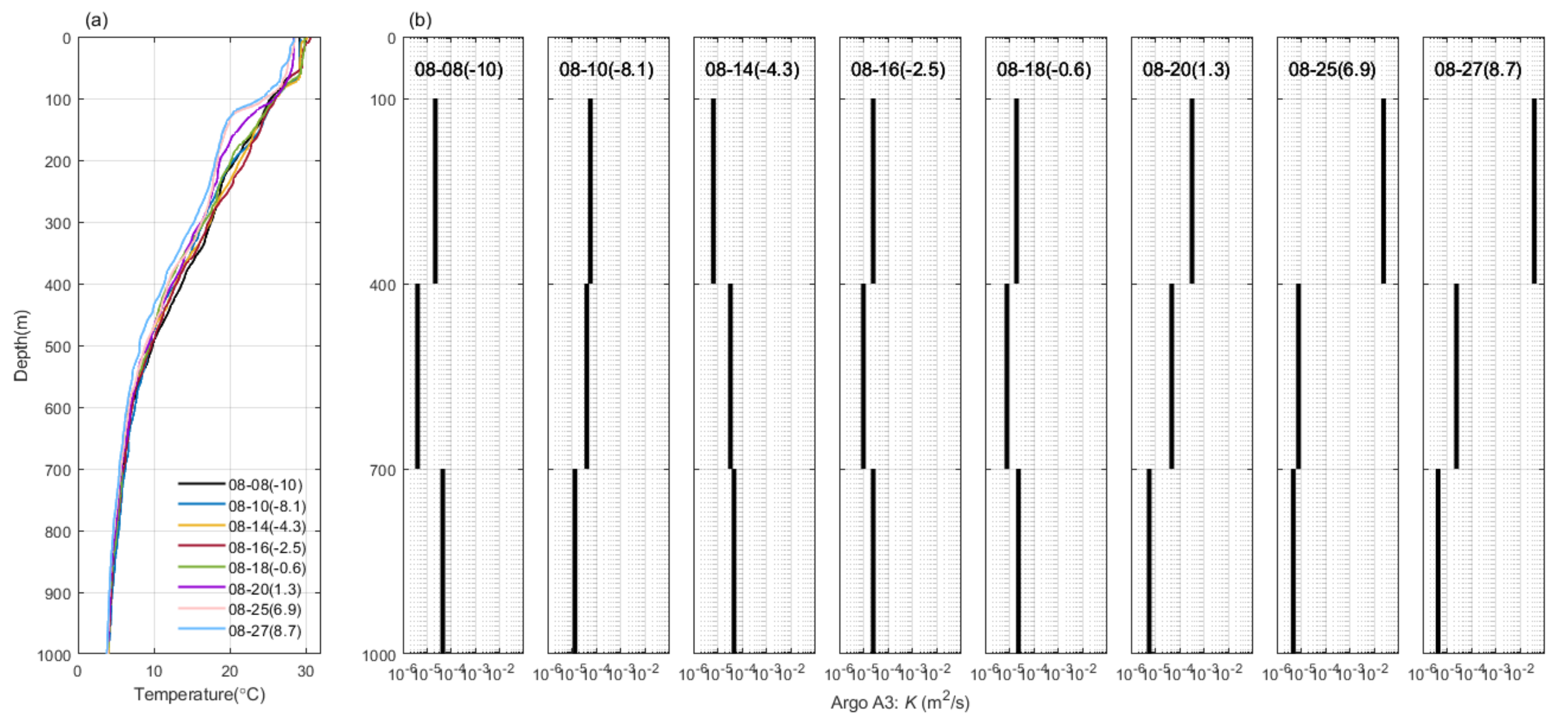
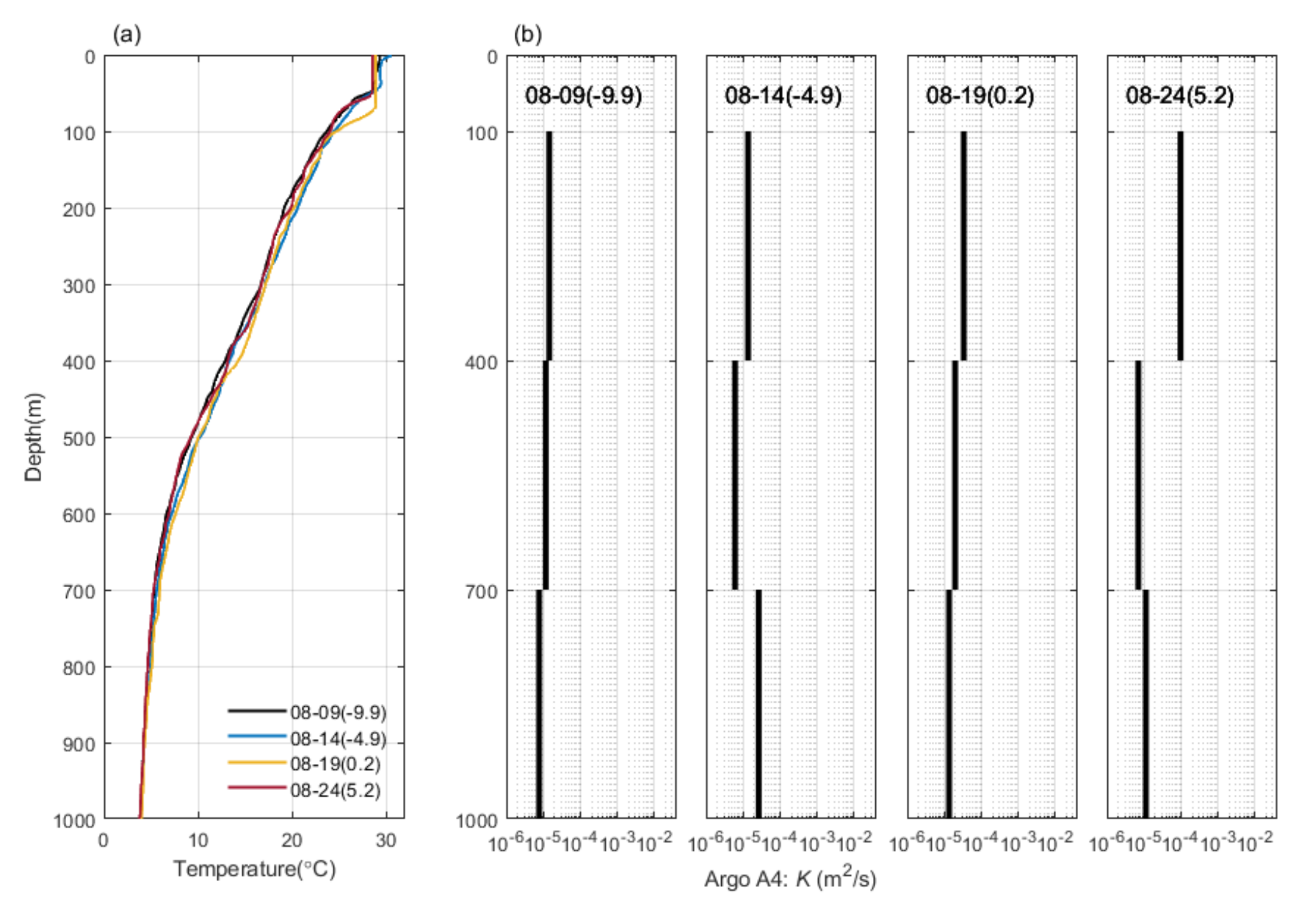
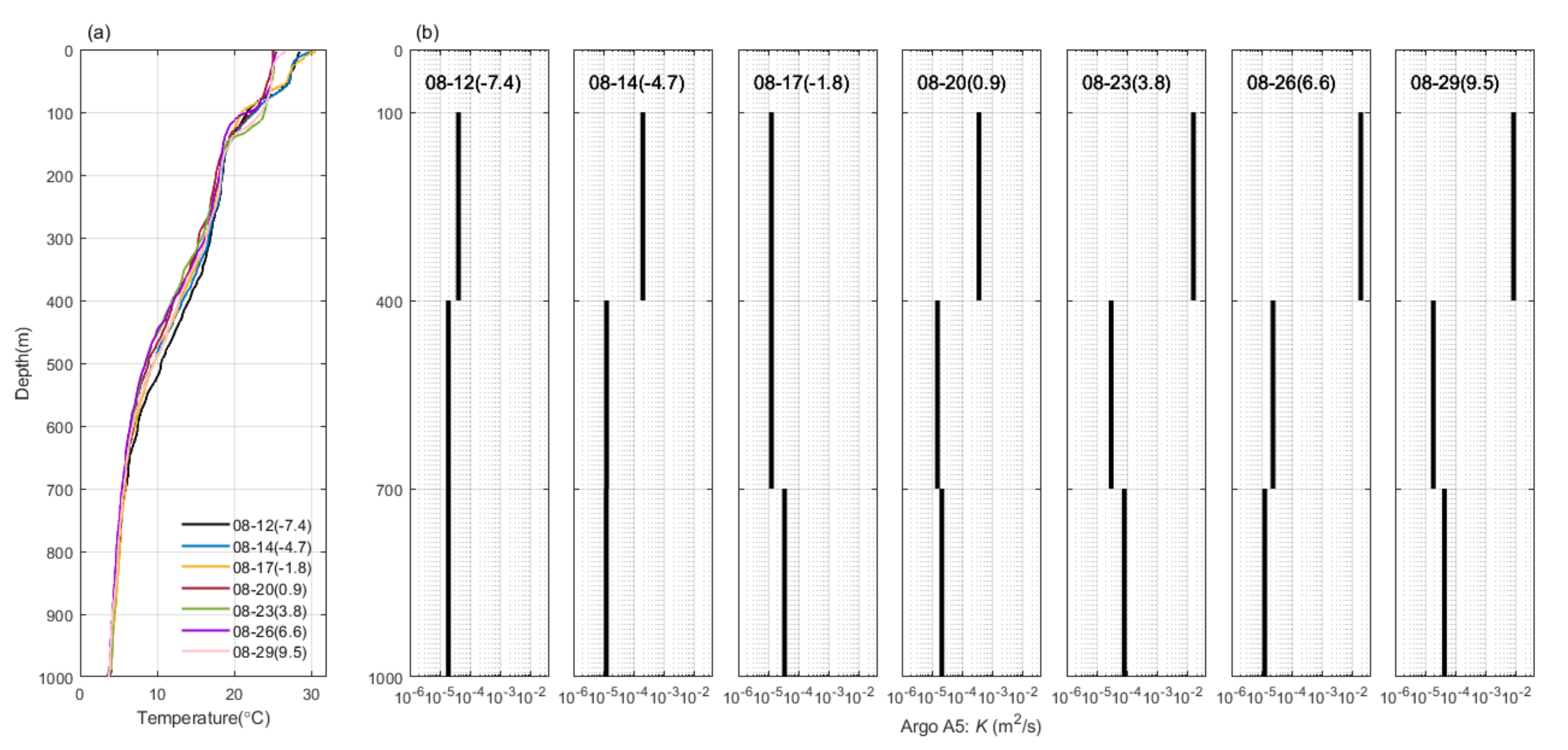
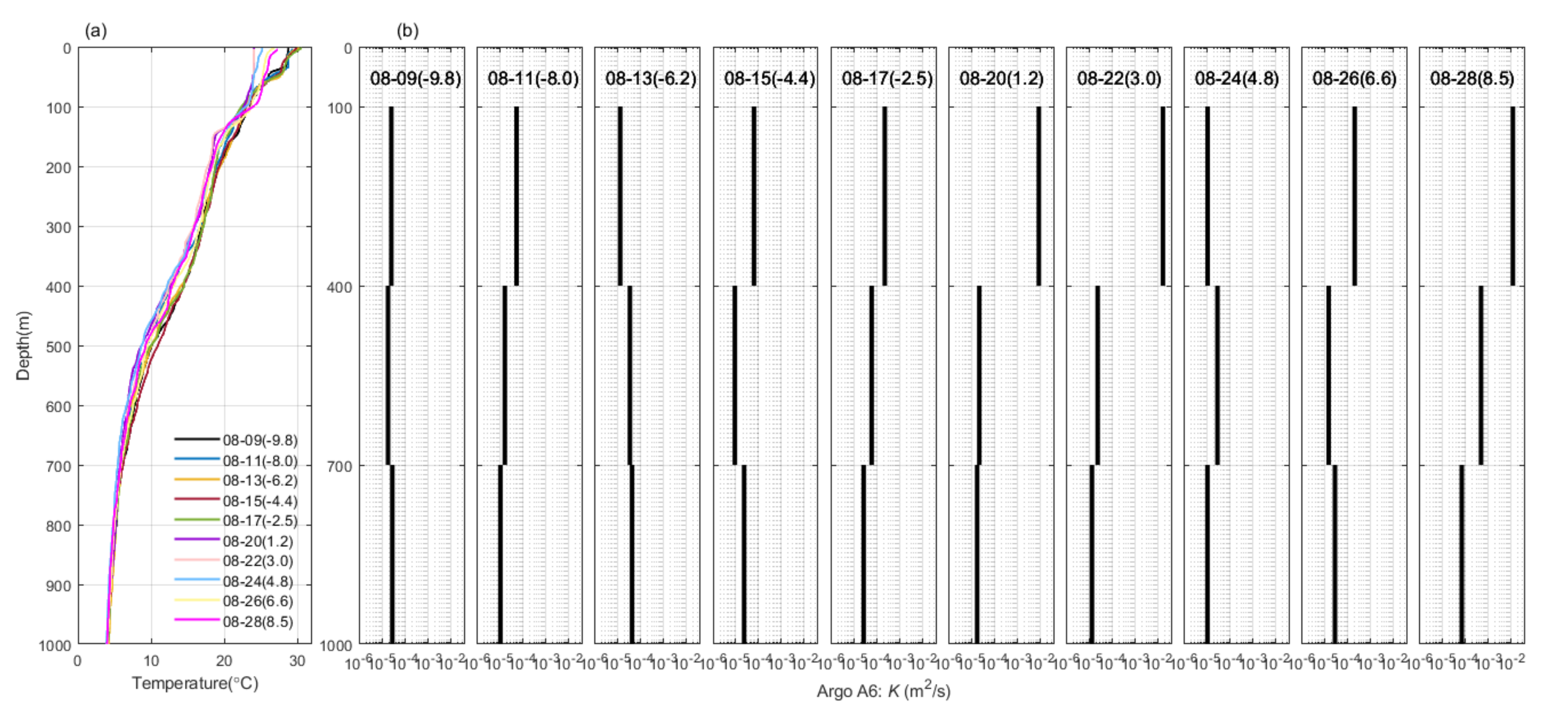
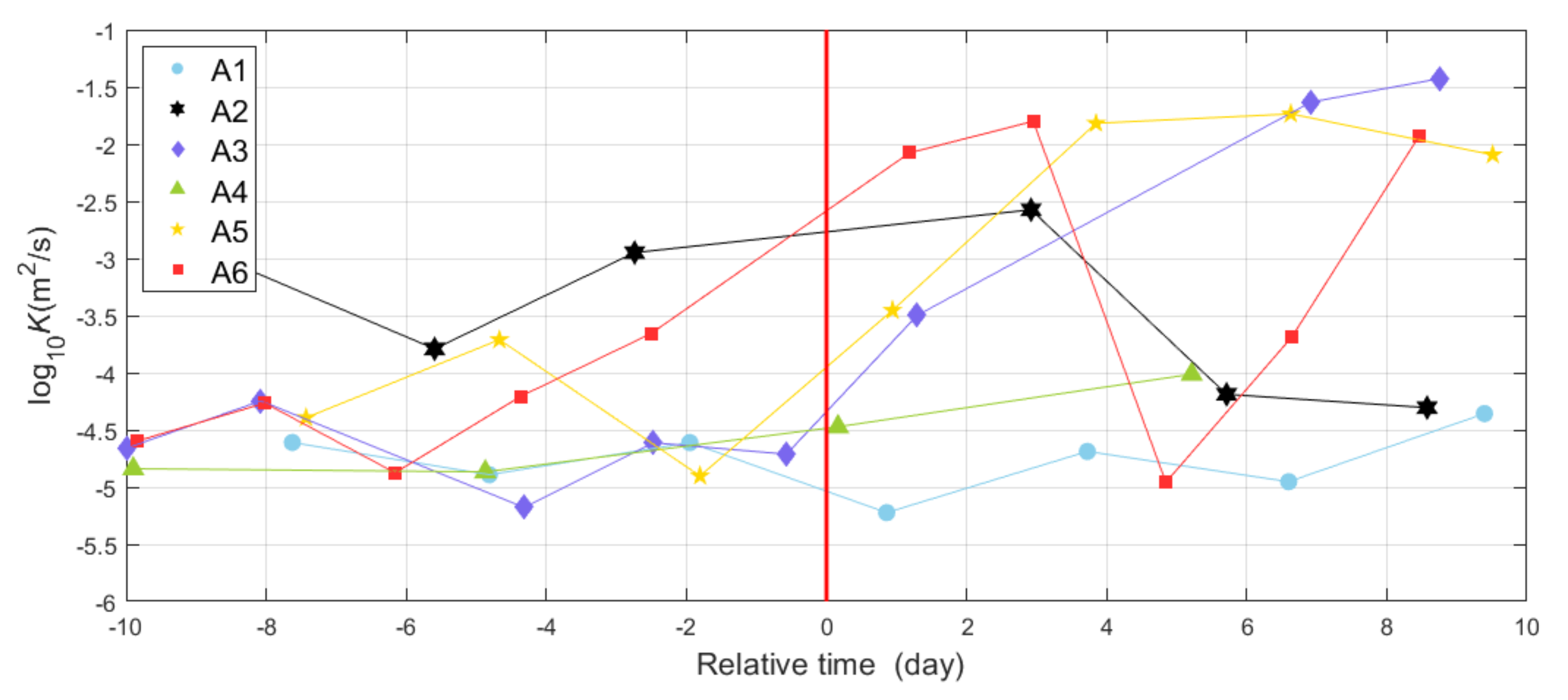
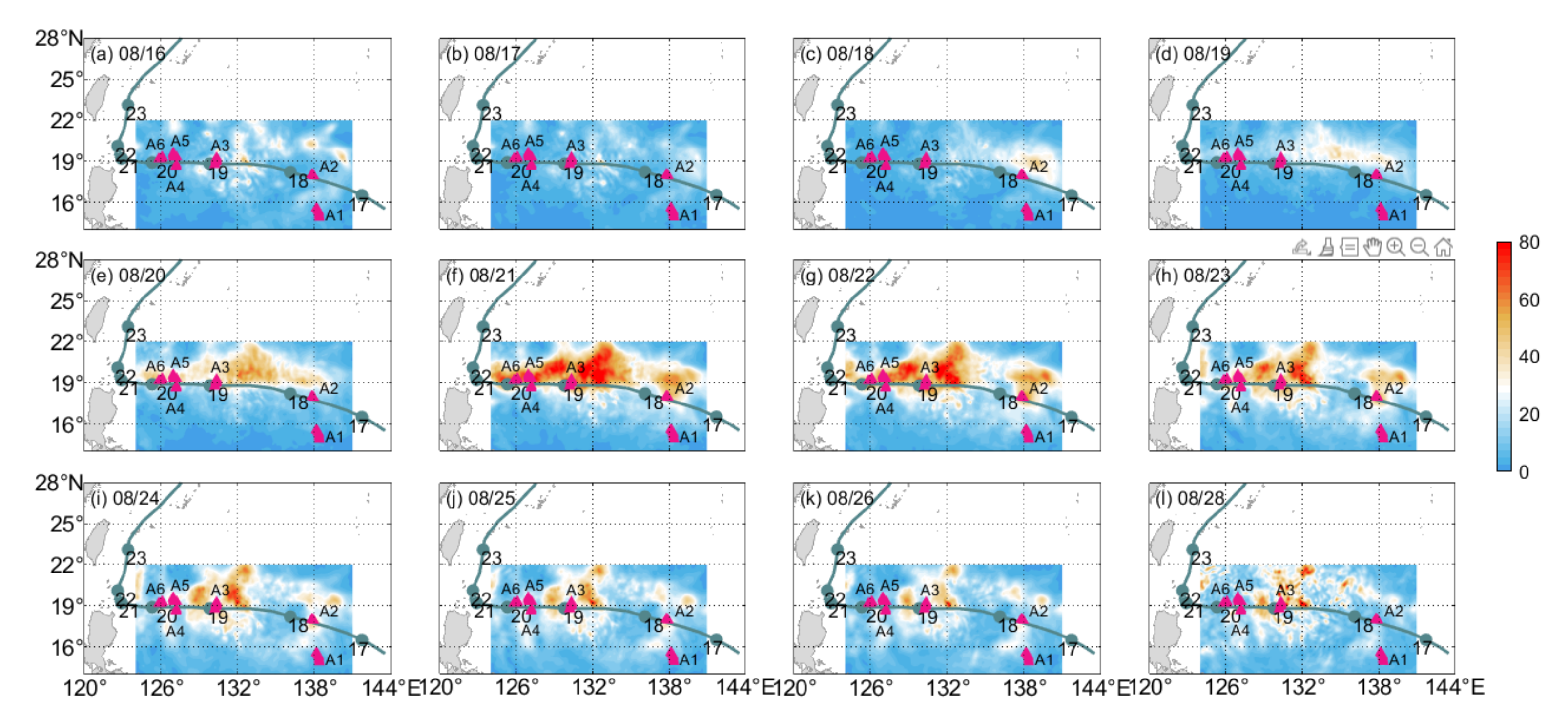

| Argo Float | WMO Number | Number of Profiles | Distance to Goni’s Center (km) | Time of Typhoon Passed (mm/dd) | Observation Time of Profiles (mm/dd) |
|---|---|---|---|---|---|
| A1 | 2901199 | 7 | 227–295 | 08/17 | 08/09, 08/12, 08/15, 08/18, 08/21, 08/24, 08/26 |
| A2 | 2901543 | 6 | 21–27 | 08/17 | 08/09, 08/12, 08/15, 08/20, 08/23, 08/26 |
| A3 | 2901579 | 8 | 4–53 | 08/19 | 08/08, 08/10, 08/14, 08/16, 08/18, 08/20, 08/25, 08/27 |
| A4 | 5904317 | 4 | 18–35 | 08/19 | 08/09, 08/14, 08/19, 08/24 |
| A5 | 2901494 | 7 | 42–78 | 08/19 | 08/12, 08/14, 08/17, 08/20, 08/23, 08/26, 08/29 |
| A6 | 2901578 | 10 | 30–47 | 08/19 | 08/09, 08/11, 08/13, 08/15, 08/17, 08/20, 08/22, 08/24, 08/26, 08/28 |
Publisher’s Note: MDPI stays neutral with regard to jurisdictional claims in published maps and institutional affiliations. |
© 2022 by the authors. Licensee MDPI, Basel, Switzerland. This article is an open access article distributed under the terms and conditions of the Creative Commons Attribution (CC BY) license (https://creativecommons.org/licenses/by/4.0/).
Share and Cite
Qiao, M.; Cao, A.; Song, J.; Pan, Y.; He, H. Enhanced Turbulent Mixing in the Upper Ocean Induced by Super Typhoon Goni (2015). Remote Sens. 2022, 14, 2300. https://doi.org/10.3390/rs14102300
Qiao M, Cao A, Song J, Pan Y, He H. Enhanced Turbulent Mixing in the Upper Ocean Induced by Super Typhoon Goni (2015). Remote Sensing. 2022; 14(10):2300. https://doi.org/10.3390/rs14102300
Chicago/Turabian StyleQiao, Mengtian, Anzhou Cao, Jinbao Song, Yunhe Pan, and Hailun He. 2022. "Enhanced Turbulent Mixing in the Upper Ocean Induced by Super Typhoon Goni (2015)" Remote Sensing 14, no. 10: 2300. https://doi.org/10.3390/rs14102300
APA StyleQiao, M., Cao, A., Song, J., Pan, Y., & He, H. (2022). Enhanced Turbulent Mixing in the Upper Ocean Induced by Super Typhoon Goni (2015). Remote Sensing, 14(10), 2300. https://doi.org/10.3390/rs14102300






